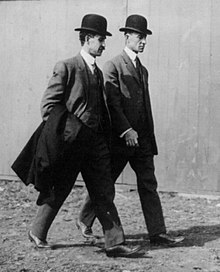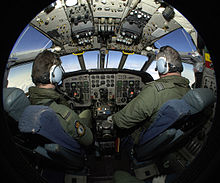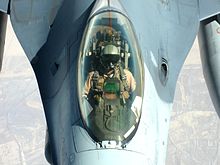Aircraft pilot: Difference between revisions
"current pilot"? |
|||
| Line 6: | Line 6: | ||
A '''pilot''' or '''aviator''' is a person actively involved in flying an [[aircraft]]. ''Pilot'' is a somewhat more precise term, as the pilot by definition directly controls the aircraft whereas the slightly broader term ''aviator'' is a person who, though actively involved in [[flight|flying]] the aircraft (whether plane, rotary-wing, powered or unpowered), does not necessarily directly control its path. People who fly aboard an aircraft, such as passengers and cabin crew, who are not involved in the aircraft's flight systems are not generally considered aviators, but crew such as [[navigator]]s, and [[flight engineer]]s are generally included.{{citation needed|date=January 2013}} |
A '''pilot''' or '''aviator''' is a person actively involved in flying an [[aircraft]]. ''Pilot'' is a somewhat more precise term, as the pilot by definition directly controls the aircraft whereas the slightly broader term ''aviator'' is a person who, though actively involved in [[flight|flying]] the aircraft (whether plane, rotary-wing, powered or unpowered), does not necessarily directly control its path. People who fly aboard an aircraft, such as passengers and cabin crew, who are not involved in the aircraft's flight systems are not generally considered aviators, but crew such as [[navigator]]s, and [[flight engineer]]s are generally included.{{citation needed|date=January 2013}} |
||
To ensure the safety of people in the air and on the ground, early [[aviation]] soon required that aircraft be under the operational control of a properly trained, certified |
To ensure the safety of people in the air and on the ground, early [[aviation]] soon required that aircraft be under the operational control of a properly trained, certified pilot at all times, who is responsible for the safe and legal completion of the flight. The [[Aéro-Club de France]] delivered the first certificate to [[Louis Blériot]] in 1908—followed by [[Glenn Curtiss]], [[Léon Delagrange]], and [[Robert Esnault-Pelterie]]. The absolute authority given to the "[[pilot in command]]" derives from that of a ship's captain.{{Citation needed|date=February 2007}} |
||
In recognition of the pilots' qualifications and responsibilities, most militaries and many airlines worldwide award [[aviator badge]]s to their pilots, as well as other [[aircrew|air crews]]. This includes [[naval aviator]]s. |
In recognition of the pilots' qualifications and responsibilities, most militaries and many airlines worldwide award [[aviator badge]]s to their pilots, as well as other [[aircrew|air crews]]. This includes [[naval aviator]]s. |
||
Revision as of 08:23, 13 October 2013


A pilot or aviator is a person actively involved in flying an aircraft. Pilot is a somewhat more precise term, as the pilot by definition directly controls the aircraft whereas the slightly broader term aviator is a person who, though actively involved in flying the aircraft (whether plane, rotary-wing, powered or unpowered), does not necessarily directly control its path. People who fly aboard an aircraft, such as passengers and cabin crew, who are not involved in the aircraft's flight systems are not generally considered aviators, but crew such as navigators, and flight engineers are generally included.[citation needed]
To ensure the safety of people in the air and on the ground, early aviation soon required that aircraft be under the operational control of a properly trained, certified pilot at all times, who is responsible for the safe and legal completion of the flight. The Aéro-Club de France delivered the first certificate to Louis Blériot in 1908—followed by Glenn Curtiss, Léon Delagrange, and Robert Esnault-Pelterie. The absolute authority given to the "pilot in command" derives from that of a ship's captain.[citation needed]
In recognition of the pilots' qualifications and responsibilities, most militaries and many airlines worldwide award aviator badges to their pilots, as well as other air crews. This includes naval aviators.
The first recorded use of the term aviator (aviateur in French) was in 1887, as a variation of "aviation", from the Latin avis (meaning bird), coined in 1863 by G. de la Landelle in Aviation Ou Navigation Aérienne ("Aviation or Air Navigation"). The term aviatrix (aviatrice in French), now archaic, was formerly used for a female aviator. These terms were used more in the early days of aviation, before anyone had ever seen an airplane fly, and it was used to denote bravery and adventure. For example, the editors at the Dayton Herald, (in an article of December 18, 1903) described the Wright brothers' first airplane: "The weight, including the body of the aviator, is slightly over 700 pounds".[citation needed]
Civilian

Civilian pilots fly privately for pleasure, charity, or in pursuance of a business, for non-scheduled commercial air-transport companies, or for airlines. When flying for an airline, pilots are usually referred to as airline pilots, with the pilot in command often referred to as the captain.
United States
In 1930, the Air Commerce Act established pilot licensing requirements for American civil aviation.
Commercial airline pilots in the United States have a mandatory retirement age of 65, having increased from age 60 in 2007.[1]
Outside the United States
In some countries, such as Pakistan, Israel, Thailand and several African nations, there is a strong relationship between the military and the principal national airlines, and many airline pilots come from the military; however, that is no longer the case in the United States and Western Europe[citation needed]. While the flight decks of U.S. and European airliners do have ex-military pilots, many pilots are civilians. Military training and flying, while rigorous, is fundamentally different in many ways from civilian piloting.
Military

Military pilots fly with the armed forces of a government or nation-state. Their tasks involve combat and non-combat operations, including direct hostile engagements and support operations. Military pilots undergo specialized training, often with weapons. Examples of military pilots include fighter pilots, bomber pilots, transport pilots, test pilots and astronauts. Military pilots also serve as flight crews on aircraft for government personnel, such as Air Force One and Air Force Two in the United States.
UAV Operators do not fall into this category because they do not fly inside the aircraft they are operating.
Military pilots are trained with a different syllabus than civilian pilots, which is delivered by military instructors. This is due to the different aircraft, flight goals, flight situations and chains of responsibility. Many military pilots do transfer to civilian-pilot qualification after they leave the military, and typically their military experience provides the basis for a civilian pilot's license.
Pilot certifications
Pilots are required to go through many hours of flight training and theoretical study, that differ depending on the country. The first step is acquiring the Private Pilot License (PPL), or Private Pilot Certificate.
The next step in a pilot's progression is either Instrument Rating (IR), or Multi-Engine Rating (MEP) endorsements.
If a professional career or simply professional-level skills are desired, a Commercial Pilot License (CPL) endorsement would also be required. To captain an airliner, one must obtain an Airline Transport Pilot License (ATPL).
Some countries/carriers require/use a Multi Crew Coordination (MCC).
Pilots in space
The general concept of an airplane pilot can be applied to human spaceflight, as well. The spacecraft pilot is the astronaut who directly controls the operation of a spacecraft, while located within that same craft (not remotely). This term derives directly from the usage of the word "pilot" in aviation, where it is synonymous with "aviator". Note that on the U.S. Space Shuttle, the term "pilot" is analogous to the term "co-pilot" in aviation, as the "commander" has ultimate responsibility for the shuttle.
Aviatrices (female aviators)

Pioneers
This section needs additional citations for verification. (August 2012) |
Pioneer aviatrices include French, Raymonde de Laroche, the world's first licensed female pilot on March 8, 1910; Belgian, Hélène Dutrieu, the first woman to fly a passenger, first woman to win an air race (1910), and first woman to pilot a seaplane (1912); French, Marie Marvingt the first woman to fly solo across the English Channel and the North Sea in a balloon (October 26, 1909) and first woman to fly as a bomber pilot in combat missions (1915); New Zealander Jean Batten was the first person to fly from England to New Zealand, Russian, Eugenie Shakhovskaya was the first female military pilot; American, Harriet Quimby, the USA's first licensed female pilot in 1911, and the first woman to cross the English Channel by airplane; American Amelia Earhart, the first woman to fly solo across the Atlantic (1932); Bessie Coleman, the first African American female to become a licensed airplane pilot (1921); German, Marga von Etzdorf, first woman to fly for an airline (1927).
Opal Kunz, one of the few women to train US Navy fighter pilots during World War II in the Civilian Pilot Training Program; Edith Maud Cook, who made numerous parachute jumps from balloons, learned to fly in France and was possibly the first British woman to do so. Hilda Hewlett opened a flying school with her aviator husband and was the first woman to gain a RAeC certificate. Amy Johnson, the first woman to fly solo from Britain to Australia (1930). Valérie André, a French neurosurgeon and member of the French army, became the first woman to fly a helicopter in combat, while serving in Indochina (1945). Jean Batten, a New Zealander, made a number of record-breaking solo flights across the world, including, in 1936, the first-ever solo flight from England to New Zealand.
As well as being Turkey's first aviatrix, Sabiha Gökçen, born in 1913, became the world's first female fighter pilot at the age of 23.[2][3]
In 1979, a Jamaican, Maria Ziadie-Haddad, became one of the first women in the Western Hemisphere to become a commercial jet airline pilot when she was hired by Air Jamaica 1968 Ltd as a B727 Second Officer.[4]
Soviet Union
The Night Witches, a women-only combat regiment of the Soviet Air Forces, flew harassment bombing and precision bombing missions from 1942 to the end of the World War II.
Pakistan
Pakistani pilot Ayesha Farooq was the first female fighter pilot for the Pakistani airforce. At least 19 women became pilots in the air force in the decade from 2003.[5]
China
China has trained more than 500 female pilots since 1951. Large numbers have been trained to fly China's most advanced combat jets, including the J-10.[6]
United States

Until the 1970s, aviation had been a traditionally male occupation in the United States. Commerce Department regulations virtually required pilots to have flown in the military to acquire sufficient flight hours, and until the 1970s, the U.S. Air Force and Navy barred women from flying,[7] thus also preventing them from moving into commercial piloting[citation needed] Despite women being trained by the US Army Air Corps and flying every advanced military aircraft the US built (including every bomber, pursuit plane, and the first jet) during WWII as Women Airforce Service Pilots (WASP), this program was disbanded in December 1944 and commercial jobs were not generally available to women, though these highly trained women flew as instructors and pilots for flying services throughout the United States. Women began to enter U.S. major commercial aviation in the 1970s and 1980s, with 1973 seeing the first female pilot at a major U.S. airline, American Airlines, and 1986, seeing the first female captain at a major U.S. airline.[8] In the 1970s, women began being permitted to fly in the United States Armed Forces for the first time since WWII, beginning with the Navy and the Army in 1974, and then the Air Force in 1976.[9]
As of 2010, just over 7% of certified civilian pilots (both private and commercial) in the United States were women.[10]
Israel
The Israeli Air Force's flight academy is open to female pilots. 24 female pilots have completed the course as of 2011.[citation needed]
Japan
In Japan, the first female captain for commercial passenger flights was Ari Fuji, who began flying as captain for JAL Express in July 2010.[11] Fuji was rejected from admission to Japanese pilot training school on the grounds of being too small (155 cm; standard was previously 163 cm, currently 158 cm as of spring 2010), so she got her pilot's license in the United States. There are currently a few other female pilots in Japan, though, as of 2010[update], no others in a captain role.
Saudi Arabia
Hanadi Zakaria al-Hindi is the first Saudi woman to become a commercial airline pilot.[12][13]
Somalia
Asli Hassan Abade was the first female pilot in the Somali Air Force (SAF). A prominent member of the SAF, she paved the way for gender equality within the military ranks.[citation needed]
See also
- Airline pilot uniforms
- Air safety
- IMSAFE (mnemonic for pilot's fitness to fly)
- List of aerospace engineers
- List of aviators
- List of Russian aviators
- Women Of Aviation Worldwide Week, an international celebration of all women of aviation
References
- ^ Maxon, Terry (December 15, 2007). "Retirement age raised to 65 in nick of time for pilots turning 60". The Dallas Morning News. Retrieved October 15, 2009.
- ^ Sabiha Gökçen's biography, USAF Air Command and Staff College
- ^ Sabiha Gokcen biography, Hargrave Pioneers of Aviation
- ^ "Profiles of Jamaican Women". Discover Jamaica. Retrieved May 23, 2010.
- ^ Pakistan's first woman combat pilot
- ^ China's female combat pilots
- ^ Becoming a female pilot: then and now. Usatoday.com (March 1, 2005). Retrieved on 2012-05-18.
- ^ Female Pilots Make History. Aa.com (January 16, 2012). Retrieved on 2012-05-18.
- ^ Military Women Pilots. Userpages.aug.com (March 1, 1991). Retrieved on 2012-05-18.
- ^ "2010 U.S. Civil Airmen Statistics". Federal Aviation Administration. May 2, 2010. Retrieved May 11, 2012.
- ^ First female captain no quitter, Wang Yexing, Kyodo News, reprinted in Japan Times, July 17, 2010
- ^ First Saudi Female Pilot Graduates, Arab News, 16 June 2005. Retrieved 21 October 2007.
- ^ First Saudi Female Pilot Lands Job With Kingdom Holding, 24 November 2004. Includes photo.
